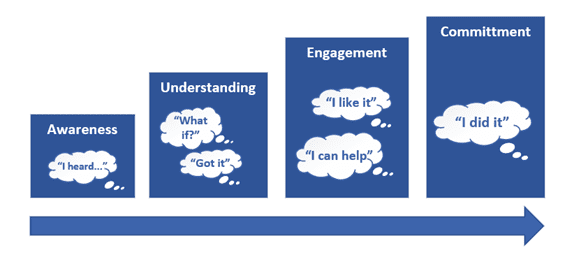Here are four helpful steps to effective organizational change management in a hybrid-remote work environment.
The world is changing in seemingly every way possible, but how can you create engagement and buy-in to organizational change that’s voluntary—and sometimes end-users, unnecessary? How can you effectively communicate, create, train, and implement new processes and systems when the receivers of this change are scattered across the country in home offices? Even more, how do you as a consultant or manager effectively execute change within an organization that isn’t even your own—never having met the people on the other end?
Below are four helpful steps that have made the implementation of a multi-tiered cross-functional organizational change not only possible but also successful:
1. Cultivate & Gauge A Level of Understanding
Clear and concise—what’s the change and how are we going to accomplish it? The first step to winning advocates and effectively implementing change is to develop a clear and meaningful message that demonstrates the what, the who, the how, and most importantly, the why. Spend time developing details of the communication plan with the recipient in mind. Once that’s communicated, spend even more time gauging the level of understanding and acceptance across the organization. With remote users, regular engagement and re-engagement will be more important than ever. Reinforcing the premise of the change through written, video, and casual communication will be key.
2. Identify Key Players
At all levels, who’ll positively influence and embody the change that was communicated? With the new hybrid-remote working environment, go one step further to identify which key players consistently and effectively connect and communicate with his or her group. Once identified, do these key groups have a solid level of understanding of the change? Target small but crucial groups of users and influential managers to reinforce the messaging from step one—winning these groups will begin a buy-in domino-effect throughout the organization. Aim to find change implementers that have a solid grasp of the business and that can create impact and maintain consistency in messaging that’ll continue throughout the organization. Once again, be sure to reengage with key members of the team that may have a low level of understanding.
3. The “Me” In Team
Dale Carnegie said it best: “There is no sweeter sound to one’s ear than the sound of his name.” The same goes for change management—communicating how an individual will benefit from a day-to-day, time-saving perspective creates investment. In step one, users should understand the overall reason behind the change and begin to gauge the level of responsibility and work expected to make it happen—now they’ll require a reason to deliver. Continuing with key communication, consultants and managers conveying “what’s in it for me” to every user and demonstrating how individuals will benefit not only from the change itself but also participation in the implementation is a pivotal piece in the organizational change management process. Empowering individuals, rather than focusing on groups, ensures that even the smallest changes and key items are executed. Individual engagement is key to achieving long-lasting commitment to change—demonstrate below with the commitment curve.
 4. Gather Feedback
4. Gather Feedback
Consistently pursuing feedback makes users feel engaged and creates a sense of ownership in the final delivery. Creating mutual goals and incorporating elements that reflect individual users’ concerns increases adoption ten-fold once changes are deployed. Along the way, this feedback also better equips the project team to create effective training documentation and identify gaps in new processes. This step is crucial not only for a successful go-live but also for a successful process and system construction.
Conclusion
The most effective organizational change management implementations begin with communication and ultimately end with buy-in and adoption from each team member. As the COVID-19 pandemic leaves its mark on the working world and professional life transitions towards accepting a hybrid-remote environment, these steps will help make leading organizational change management as seamless as possible. As professionals, we’ve learned to adapt in many ways this past year. Therefore, refreshing your approach to organizational change management to reflect the positive and necessary changes will lead to lasting impacts all around.
MORE: For more tips on effective system implementations, check out this article, which outlines six steps to achieving effective communication tactics during ETRM system implementation.
Amanda Taylor is a Senior Consultant in Opportune LLP’s Process & Technology practice in Houston. At Opportune, Amanda has been a key member of the Salesforce consulting team, creating, and implementing a wide variety of solutions for upstream, midstream, and downstream companies through the platform. Along with experience in Salesforce, Amanda has a focus on energy system integration and implementation. Amanda graduated from Texas A&M University with a BBA degree in Finance and obtained a certificate in International Business.
Oil and gas operations are commonly found in remote locations far from company headquarters. Now, it's possible to monitor pump operations, collate and analyze seismic data, and track employees around the world from almost anywhere. Whether employees are in the office or in the field, the internet and related applications enable a greater multidirectional flow of information – and control – than ever before.




